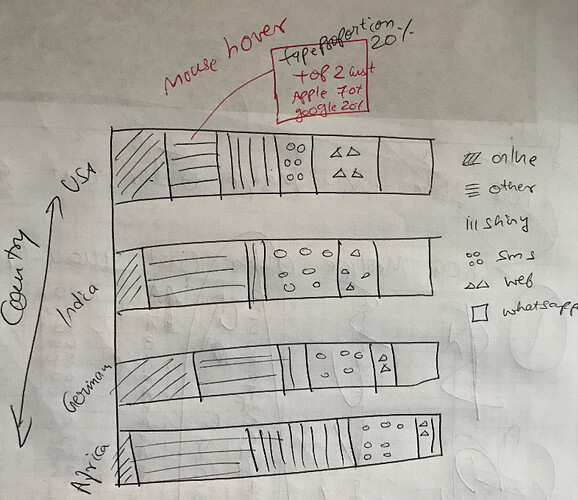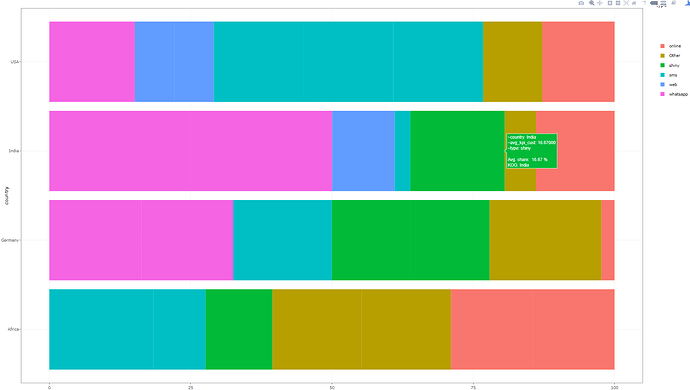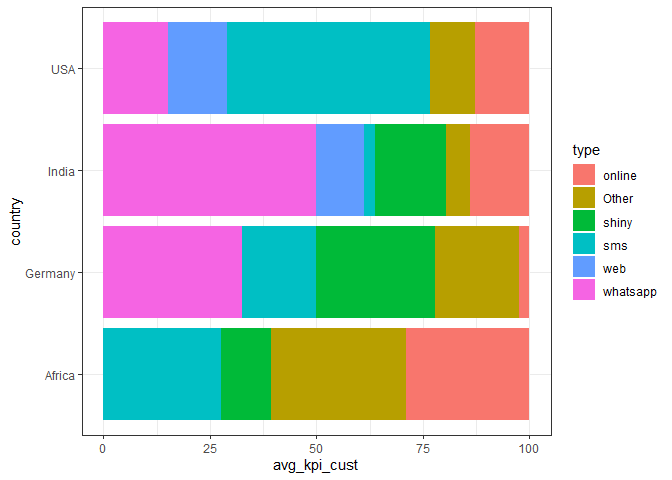Please find the input data and expected output as screenshot below:
However, the current plot with the below code:
I feel, I made it too complicated. But I shared input data and expected data along with struggled code along the way. Could you please help us
# Input data
df <- tibble(
country = c(rep(c("India","USA","Germany","Africa"), each = 8)),
type = c("sms","Other","whatsapp","web","online","shiny","whatsapp","whatsapp",
"sms","sms","sms","web","web","Other","online","whatsapp",
"sms","Other","whatsapp","shiny","online","shiny","whatsapp","whatsapp",
"sms","sms","sms","shiny","online","Other","online","Other"
),
cust = rep(c("google","Apple","wallmart","pg"),8),
quantity = c(10,20,30,40,50,60,70,80,
90,100,15,25,35,45,55,65,
75,85,95,105,10,15,20,25,
30,35,40,45,50,55,60,65)
)
# Without Customer
df %>%
group_by(country,type) %>%
summarise(kpi_wo_cust = sum(quantity)) %>%
ungroup() -> df_wo_cust
# With Customer
df %>%
group_by(country,type,cust) %>%
summarise(kpi_cust = sum(quantity)) %>%
ungroup() -> df_cust
df_combo <- left_join(df_cust, df_wo_cust, by = c("country","type"))
df_combo %>% glimpse()
# Aggregated data for certain KPIs for final plot
df_aggr <- df_combo %>%
group_by(country,type) %>%
mutate(kpi_cust_total = sum(kpi_cust),
per_kpi_cust = 100 * (kpi_cust/kpi_cust_total)) %>%
group_by(country) %>%
# In order to except from repeated counting, selecting unique()
mutate(kpi_cust_uniq_total = sum(kpi_cust) %>% unique(),
per_unq_kpi_cust = 100 * (kpi_cust/kpi_cust_uniq_total) %>% round(4))
#
plt = df_aggr %>% ungroup() %>%#glimpse()
# In order to obtain theTop 2 customers (Major contributor) within country and type
# However, if this code is used, there is an error
# group_by(country, type) %>%
# nest() %>%
# mutate(top_cust = purrr::map_chr(data, function(x){
# x %>% arrange(desc(per_kpi_cust)) %>%
# top_n(2,per_kpi_cust) %>%
# summarise(Cust = paste(cust,round(per_kpi_cust,2), collapse = "<br>")) %>%
# pull(cust)
# })#,data = NULL
# ) %>%
# unnest(cols = data) %>%
group_by(country, type) %>%
# If mutate is used, undesired stripes appear on the plot
# Summarize used, then it is not adding to 100%
mutate(avg_kpi_cust = per_unq_kpi_cust %>% mean()) %>%
#summarise(avg_kpi_cust = per_unq_kpi_cust %>% mean()) %>%
ggplot(aes(x = country,
y = avg_kpi_cust,
fill = type,
text = paste('<br>proportion: ', round(avg_kpi_cust,2), "%",
"<br>country:",country
))) +
geom_bar(stat = "identity"#, position=position_dodge()
) +
coord_flip() +
theme_bw()
ggplotly(plt)

